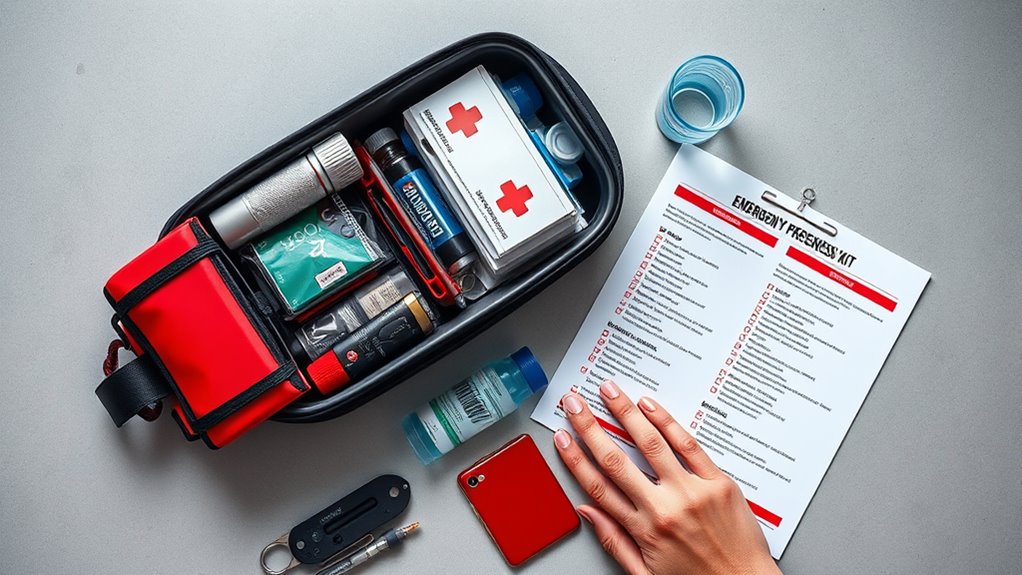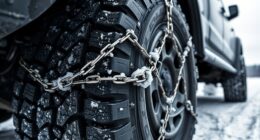To troubleshoot your emergency kit quickly, gather all supplies in one accessible spot, then check expiration dates and replace outdated items like food, water, or medications. Inspect containers and tools for damage, leaks, or wear. Verify everything is organized with clear labels, and confirm that critical items are easy to reach. Refill consumables and batteries as needed. Keep your info updated and stick to a regular check schedule—stay tuned for more tips to keep your kit ready.
Key Takeaways
- Verify accessibility by quickly checking that all items are in designated, unobstructed locations.
- Conduct a rapid visual inspection for expired supplies or damaged containers.
- Confirm essential items like water, first aid, and batteries are present and functional.
- Update digital and physical inventory logs to identify missing or outdated supplies.
- Ensure emergency contact information and critical documents are current and easily retrievable.
Gather Your Emergency Kit and Supplies

Before an emergency happens, you need to gather all essential supplies into a ready-to-go kit. Choose a designated storage location that’s easily accessible and known to everyone in your household. This guarantees you can grab your kit quickly when needed. Use a clear labeling system to organize your supplies, so you can find items fast, even in stressful situations. Label compartments or containers with categories like water, food, first aid, and tools. Keep your kit in a durable, portable container to prevent damage and make transportation easy. Regularly review the storage location to confirm it’s accessible and free of obstructions. A well-organized, labeled kit ensures you’re prepared and can respond swiftly when emergencies strike.
Check Expiration Dates and Replace Outdated Items
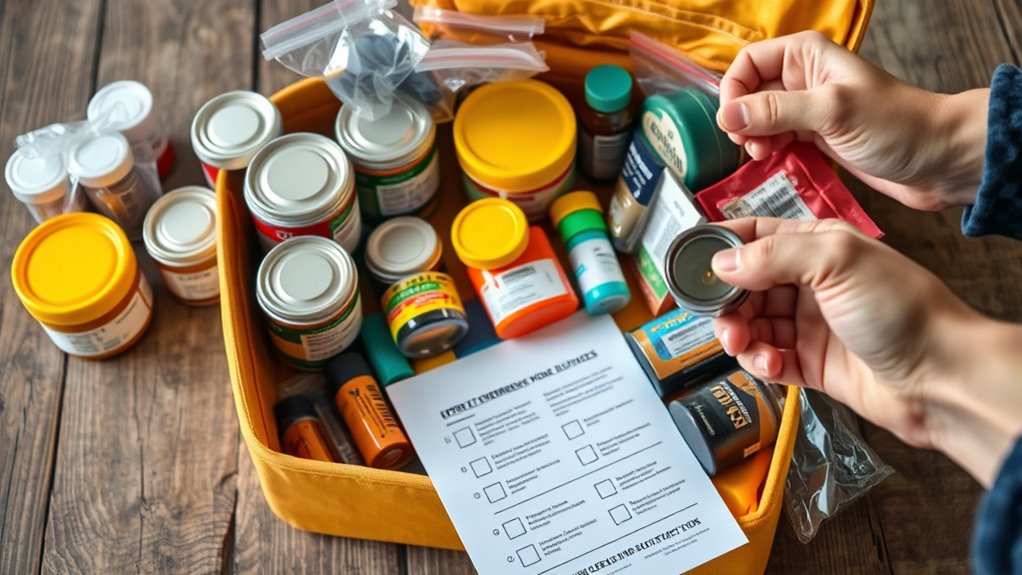
You need to regularly check the expiration dates on your emergency supplies to guarantee they’re still safe and effective. When you find expired items, replace them promptly with fresh stock. Staying on top of this keeps your kit reliable when you need it most.
Verify Item Expiry Dates
Checking the expiration dates on your emergency supplies is essential to guarantee everything is safe and effective when needed. An expiration check helps you identify items that may no longer provide proper protection or nutrition. Take a moment to carefully examine each item in your kit and note the renewal dates. Remember, expired supplies can compromise your safety during an emergency.
- Feel confident knowing you’re prepared with fresh, reliable supplies when disaster strikes
- Avoid the risk of using outdated items that might fail when you need them most
- Ensure your kit is always ready, giving you peace of mind in a crisis
Replace Expired Supplies
Once you’ve identified expired items during your inspection, it’s time to replace them with fresh supplies. Focus on perishable items like food and water, ensuring they’re within their expiration dates. Check medication expiration dates carefully, as expired medication can lose effectiveness or become unsafe. Replace any outdated medications with new ones, and discard any items that are past their prime. Don’t forget to inspect first aid supplies, batteries, and other perishable or time-sensitive items. Keeping your kit stocked with current supplies ensures you’re prepared when disaster strikes. Regularly updating these items minimizes risk and guarantees your kit remains reliable. Remember, expired supplies diminish the kit’s overall effectiveness, so make replacing them a priority during your inspections.
Maintain Fresh Stock
How often should you verify that your emergency supplies are current? Regularly checking your stock ensures you’re prepared when it counts. Use inventory tracking to monitor expiration dates and identify outdated items. Practice stock rotation by placing newer supplies behind older ones, so nothing expires unnoticed. This keeps your kit fresh and reliable.
Stay vigilant with these steps:
- Review expiration dates monthly to prevent surprises during emergencies
- Replace outdated items immediately to maintain safety and effectiveness
- Keep a detailed inventory log to track stock levels and expiration dates
Remaining proactive with inventory tracking and stock rotation ensures your kit stays ready. By maintaining fresh stock, you protect yourself and your loved ones, giving peace of mind in uncertain moments.
Inspect for Physical Damage and Wear
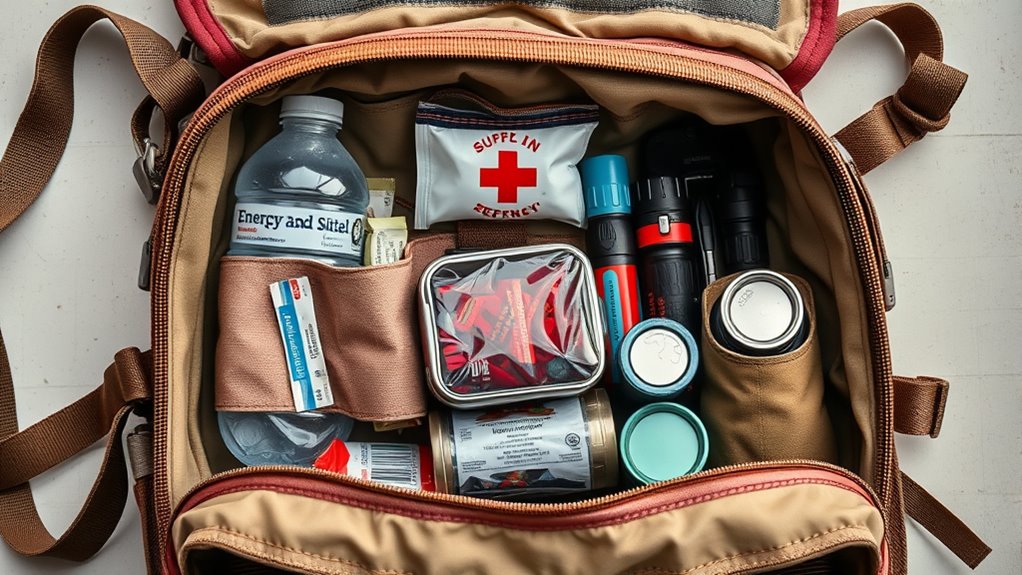
Regularly inspecting your emergency preparedness kit for physical damage and wear is essential to guarantee all items remain functional when needed. During a physical inspection, check for cracks, corrosion, leaks, or broken seals on containers and tools. Pay close attention to batteries, flashlights, and other electronics, ensuring they haven’t corroded or deteriorated. Conduct a wear assessment on clothing, blankets, and first aid supplies to confirm they’re intact and free from tears or discoloration. Look for any signs of deterioration, such as rust or mold, especially on metal or fabric items. Address any issues immediately by repairing, replacing, or discarding compromised items. Performing these checks helps prevent surprises during an emergency and ensures your kit is always ready when it matters most.
Verify Accessibility and Organization of Items
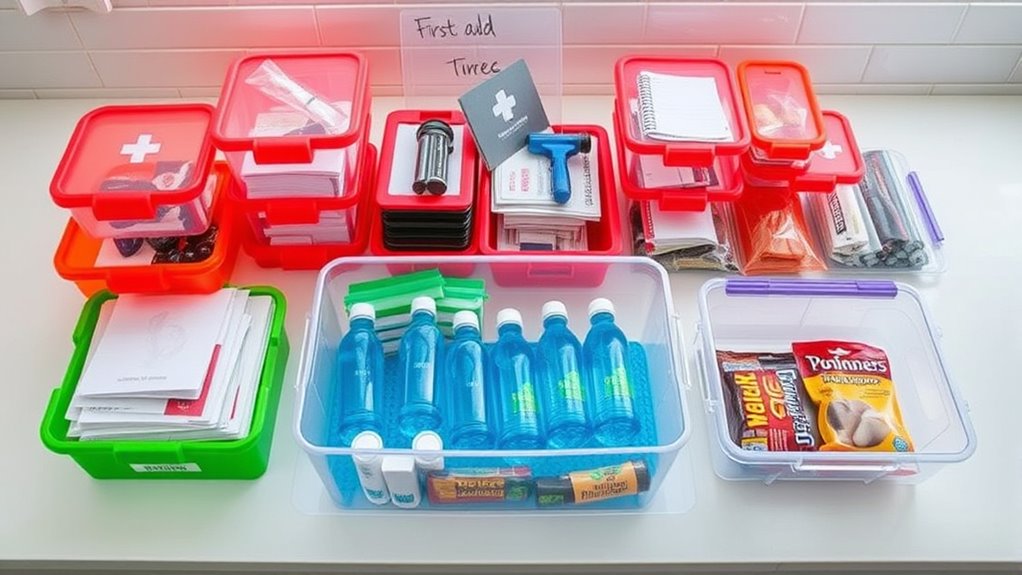
Make sure your emergency kit items are properly organized and easy to reach. Check that each item is in its designated spot and accessible without obstacles. Confirming these details helps you grab what you need quickly during an emergency.
Check Item Placement
To make sure your emergency kit is ready when you need it, you should verify that all items are accessible and properly organized. Check the storage location to ensure everything is in its designated spot. Proper item arrangement makes it easier to grab essentials quickly during an emergency. Confirm that your supplies are visible and not buried under unnecessary clutter. If items are misplaced or hard to reach, delays could be dangerous. Be sure to revisit the placement periodically, especially after use or relocation. An organized kit provides peace of mind, knowing you can find what you need instantly. Remember, the right storage location and thoughtful item arrangement are critical for an effective emergency response. Keep your kit simple, accessible, and well-structured.
Confirm Easy Access
Have you checked that all your emergency supplies are easy to reach? Ensuring quick access is crucial during an emergency. First, verify storage safety by placing frequently used items in easily accessible locations, avoiding high shelves or tightly sealed containers. Next, confirm label clarity on all boxes and bags; clear labels help you identify supplies instantly, saving precious time. Organize your kit so essentials like water, first aid, and flashlights are grouped together and visible. Regularly review your setup to make sure nothing has shifted or become buried. Proper organization and straightforward labeling reduce confusion and delays. When your supplies are stored safely and labeled clearly, you’ll feel confident knowing you can access what you need quickly when it counts most.
Restock and Refill Consumables and Batteries

Regularly restocking and refilling consumables and batteries is crucial to keep your emergency preparedness kit ready for action. Without fresh supplies, you risk being unprepared when disaster strikes. Check your water purification supplies to guarantee they’re functional, and review your medication stockpiling to prevent shortages. Replace expired items and update your inventory to match current needs. Remember, fresh batteries power essential devices like flashlights and radios, which are indispensable during emergencies. Don’t forget to verify the age and usability of all consumables, including food and water. Keeping everything current ensures you’re prepared to face unexpected situations confidently.
- Restock water purification supplies to keep water safe
- Replenish medication stockpiling for health security
- Replace expired batteries and consumables for reliability
Update Personal and Contact Information
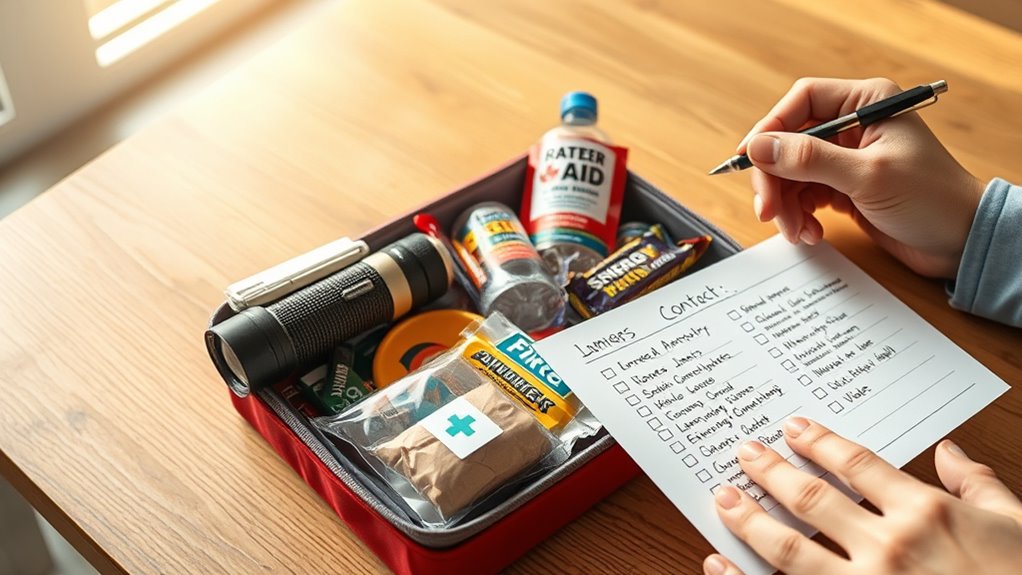
Is your emergency contact list up to date? Regularly reviewing your contact information guarantees you can reach your emergency contacts quickly when needed. Check that all phone numbers, addresses, and email addresses are current for each person listed. Update any outdated information to prevent delays during an emergency. Confirm that your emergency contacts include trusted friends, family members, and neighbors who can assist or provide support. Keep a printed copy of your updated list in your emergency kit and a digital version on your phone. Remember, having accurate contact information helps responders and loved ones stay connected and coordinated. Take a few minutes now to review and refresh your emergency contacts—it’s a simple step that can make a big difference in a crisis.
Create a Maintenance Schedule and Record Keepings
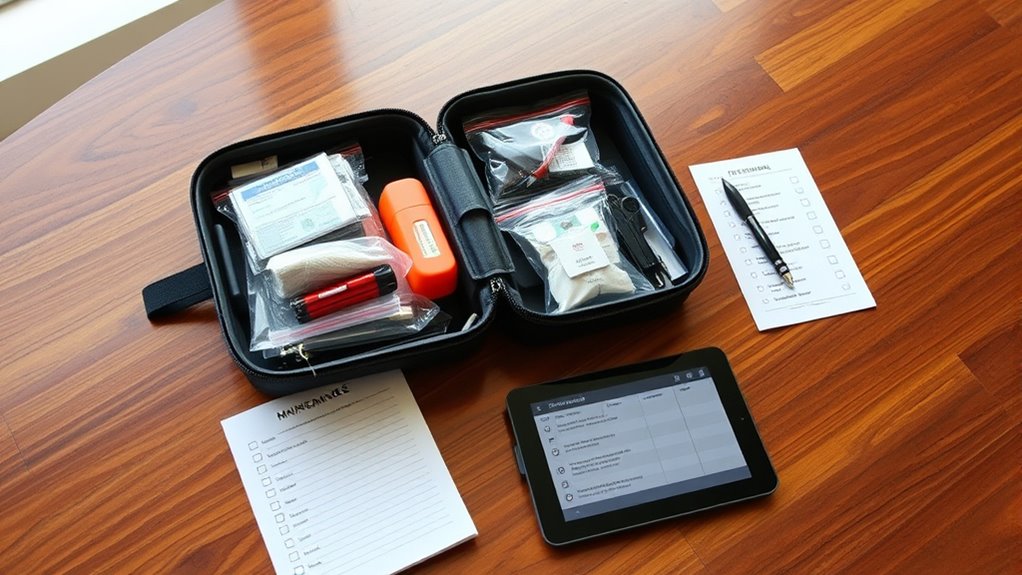
Keeping your emergency contact list current is just the first step; maintaining your emergency kit requires ongoing attention. To stay prepared, create a maintenance schedule and keep detailed records. Regular inventory tracking ensures you know what supplies need replenishing, preventing shortages during emergencies. Use schedule planning to set reminders for monthly checks, so nothing falls through the cracks. This proactive approach helps you identify expired items, damaged equipment, or missing essentials. Record keepings keep your updates organized, giving you peace of mind that your kit is ready when needed. Staying disciplined with these routines fosters confidence and reduces panic during crises. Remember, a well-maintained kit isn’t just about having supplies; it’s about being ready for anything, anytime.
Frequently Asked Questions
How Can I Quickly Identify Missing or Overlooked Items in My Kit?
You can quickly identify missing or overlooked items by using your supply inventory and an updated inventory checklist. First, lay out everything in your kit and compare it against your checklist. Cross off items as you verify their presence. This straightforward process helps you spot missing essentials fast. Regularly updating your inventory checklist guarantees you catch any gaps early, keeping your emergency preparedness kit complete and reliable.
What Tools Are Best for Inspecting the Physical Integrity of Supplies?
You should use safety seals to check if supplies have been tampered with or opened. Conduct durability tests by examining the packaging for tears, dents, or signs of wear that could compromise contents. Inspect containers, batteries, and medical supplies closely, ensuring they’re intact and functional. A thorough visual check helps identify any damage or expiration issues quickly, so your kit remains reliable when you need it most.
How Do I Prioritize Items for Replacement During Limited Time?
Imagine a hurricane warning; you must quickly prioritize. Start with essential items like water, food, medications, and first aid supplies, as these are critical for survival. Use inventory management to identify expired or damaged items and mark them for immediate replacement. Implement a simple replacement scheduling system to guarantee your kit stays ready. Focus on high-priority essentials first, then replenish secondary items once the immediate threat has passed.
What Are Signs That an Item Is No Longer Safe to Use?
You’ll know an item isn’t safe when you notice signs like aging batteries that no longer hold a charge or rusty cans that may be compromised. Check for corrosion, leaks, or unusual odors, which indicate deterioration. If batteries are weak or swollen, replace them. Rusty cans could contaminate contents. Regularly inspect your kit, and if any item shows these signs, replace it immediately to guarantee your safety during emergencies.
How Often Should I Conduct Emergency Kit Drills or Practice Checks?
You should conduct emergency kit drills or practice checks at least twice a year. During these checks, focus on storage organization and kit labeling to guarantee everything is easy to find and accessible. Regular practice helps you identify missing or expired items and keeps you familiar with your kit’s layout. By doing this, you’ll stay prepared and can quickly respond when an emergency arises, reducing stress and confusion.
Conclusion
By briskly bouncing between your basic backups, you’ll banish barriers and build a bulletproof barrier of preparedness. Keep your kit current, check for damage, and organize with ease. Regular refreshes and record updates guarantee you’re ready for any emergency encounter. With a swift, systematic sweep, you’ll stay safe, secure, and suddenly savvy. Stay sharp, stay steady, and let your preparedness be the powerful protector that paves the path to peace of mind.

